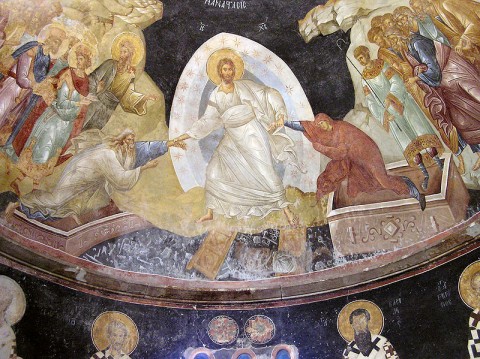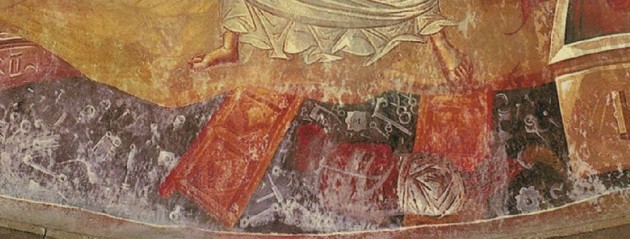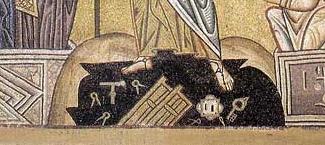Saturday, September 10th, 2011
Fragments of the Gates of Hell
For those of you who follow me on Twitter, you may have noticed I my tweets about Byzantine art over the past day or so. I’ve been revisiting Byzantine art this past week – it’s been quite a while since Justinian and I have hung out together. And I can always use more gold backgrounds in my life, right?
Today, while finishing up my Byzantine projects, I happened to notice some fun details in “anastasis” depictions that have caught my attention. ”Anastasis” is the Greek word for “resurrection.” Depictions of anastasis don’t reference the biblical story of Christ’s resurrection, but are inspired by the Gospel of Nicodemus (also called “Acts of Pilate”), an apocryphal text. These scenes show a triumphant, victorious Christ who has broken the Gates of Hell in order to rescue his Hebrew forbearers. Probably the best known anastasis painting is this one:

Anastasis, Funerary chapel of Theodore Metochites, located at the Monastery of Christ in Chora, 1310-1321
Here, Christ is shown rescuing Adam and Eve from their tombs. Other patriarchs, prophets, and kings wait on the sidelines – perhaps waiting their turn to be rescued by Christ. I like a lot of things in this painting, particularly that Christ and Adam are dressed in similar white robes. Since Christ was perceived as a “new Adam” to reverse the effects of the Fall, I think it’s fitting that they are depicted in matching clothes.
Anyhow, what I noticed today were details at the bottom of this wall painting. The Gates of Hell are depicted in reddish panels, located underneath Christ’s feet. In between the two gates is the defeated Satan, who is wrapped in a bundle. Underneath Christ’s feet there are a bunch of tiny fragments:

Anastasis, detail of funerary chapel of Theodore Metochites, located at the Monastery of Christ in Chora, 1310-1321
It turns out that these fragments are keys, nails, hinges, bolts, locks, and other tiny bits from the locks which sealed the Gates of Hell shut. Christ, in his triumph over death, has burst through the Gates of Hell with a dramatic gesture. From a historical standpoint, these different depictions are especially valuable to scholars and archaeologists. Some scholars have found that this fresco includes the most detailed depictions of keys, locks, etc., that exist and have compared the wall painting to actual historical artifacts.1
I decided to look at the Gospel of Nicodemus to see if there were any specific references to keys, locks, or the Gates of Hell. There are a few references, particularly Chapter V (XXI): 1-3. Christ announces his arrival at the doors, and Hell cries “unto his wicked ministers: Shut ye the hard gates of brass and put on them the bars of iron and withstand stoutly, lest we that hold captivity be taken captive” (Verse 1). The captive saints in Hell protest against this action, and King David reminds Hell that Christ is the individual who “hath broken the gates of brass and smitten the bars of iron in sunder” (Verse 2).
The artist for the funerary chapel of Theodore Metochites really took the “in sunder” description to heart! Other Byzantine artists also depicted this scene, but usually with less fragments of locks and keys. Here are three other anastasis scenes that include some keys and pieces of the “bars of iron.” I’m showing details of the images below, but also providing links in case anyone wants to see the full scene.

From the Anastasis, at Hosios Loukas, Greece
Detail of Anastasis, Russian icon from 17th century (Hermitage Museum). Detail image courtesy of jimforest via Flickr[/add_caption_link].

Detail of Anastasis, west vault from Cathedral of St. Mark, Venice, c. 1180
These artists have left the Gates of Hell in shambles – it’s no wonder anastasis scenes are sometimes called the “Harrowing of Hell!”2 If you know of any other anastasis scenes that have fun depictions of keys, locks, bolts, hinges and the like – please let me know!
1 George Fletcher Bass and James W. Allan, Serçe Limanı: An Eleventh-Century Shipwreck Vol. 2, (College Station, Texas: Texas A&M University Press, 2009), 449. Available online here.
2 If you want to be nitpicky, though, I think it’s more accurate to refer to Byzantine works of art as “anastasis.” The term “Harrowing of Hell” is an Old English and Middle English term, so it doesn’t perfectly apply to the Byzantine period.
Hi Alberti,
Here's a more creatural version from SquinchPix:
http://www.squinchpix.com/searchn.php?zoom_query=^6298&zoom_and=0
Best,
Bob Consoli
…also, Christ releasing the souls from Purgatory (Renaissance version):
http://www.squinchpix.com/searchn.php?zoom_query=^13577&zoom_and=0
Gawd, who doesn't need more gold backgrounds in their life? :p
I don't have any paintings of the anastasis with keys and locks that spring to mind, but I do know that clergy performed a dance to symbolize the anastasis within French Gothic cathedral labyrinths, which I suppose are a sort of lock. A puzzle, at the very least.
Hi Bob! Thanks for including those images. They are quite complimentary to the "anastasis" images that I posted here. I especially like the blue demon in the Santa Maria Novella fresco. Fun!
heidenkind: That's an interesting thought! Are you thinking about the one at Chartres? Those cathedral mazes are a puzzle, to say the very least. I have heard a lot of theories about that maze. My favorite is that the priests would walk along these mazes as a type of penance or a symbolic journey into the spiritual realm of God. I've never heard that the mazes are related to Purgatory/anastasis, but I think that's an interesting idea!
Another really cool post. Wish I knew the Bible better… I didn't even know there were saints in hell….
Cheers for the great post M! It's always fascinating to see these wonderful nuances in Byzantine art.
Even with the more formalised guidelines for depiction of figures seen in Byzantine art, one could argue that artists inserted something of their own individuality into these more imaginative depictions, particularly as it was not the custom for artists to blatantly self-identify in their works.
Also intriguing is the mining of the apocrypha for content, something which stayed popular throughout the middle ages and Renaissance but diminished after the Council of Trent.
From an iconographical perspective, they provided artists with wonderful sources of fantastical imagery!
If you've been focusing on the Byzantine era to prepare content for your students, don't forget the amazing free resources and online exhibitions on Byzantine Art at the Met Museum website, including the Heilbrunn Timeline of course
Sounds like fun! (keep your eye out for errant storks on rooftops!
H
Thanks for the comments, hcr and H Niyazi!
hcr: Your comment made me think about how many art historians are completely familiar with the Bible. I have a solid foundation of the Old and New Testament, but I there are a lot of apocryphal texts that I don't know very well. But that's the great thing about blogging: it gives me a reason to study and write about these apocryphal texts!
H: Thanks for the references! You're right: these kinds of texts definitely provided a lot of artistic inspiration for fantastical imagery. It's great stuff!
Dancing has been connected with labyrinths since ancient times (Ariadne taught Theseus the "dance of life and death"). At Auxerre, Sens, Chartres, Reims, and Amiens, there are accounts of people (usually just the bishop) dancing to the center of the labyrinth while holding a ball in one hand (like a ball of thread) and then dancing back out again in connection with Easter celebrations. Other clergy and/or the congregation always danced as well, although exactly what they did depended on the cathedral. The whole thing with a single person taking a meditative pilgrimage by following the path of a labyrinth actually started in the 19th century and doesn't have much to do with their original purpose.
heidenkind: That's so cool! Thanks for sharing! I've never heard any of this before. I'm going to have to look more up on this topic. I'm going to be giving a lecture on Easter processions in a couple of weeks (granted, it will be in connection with Brazilian art and not French art), but I'd still love to look into this topic more.
I have read an article by Vincent Scully that talks about how the labryinth layout of Knossos is connected with life/death. (It's located in the "Feminism and Art History" book.) He compares the labyrinth to the layout of a cave, and discusses how the dancing of prehistoric cave rituals (back and forth, in and out of passages) is similar to the dancing that is physically mandated by the labyrinth layout design. One is forced to dance back and forth, aren't they?
Cool stuff. I'm seeing a whole historical trend here, from prehistoric caves to Easter processions. 🙂
I don't think I've read that article, I will have to check it out. But it's actually Dan-Brown-ish how consistent French Gothic cathedral labyrinths were with their ancient counterparts, and they were pretty blatant about it (which is why most of them didn't survive).
I have a theory that ballet is the modern descendant of the original labyrinth dance, though I doubt I'd ever be able to prove it.
It’s details like this that make me want to continue my education in Religous Art History. Thanks for the great post!!! (And the new website looks awesome!)
I love religious art because of these rich details to story that the artist included in their work. Hcr you’re not the only one who didn’t know the Bible, to these artist’s viewers Religious Art was the only scripture they would have a chance to “read.” As their religious leaders spoke the Bible words in latin they could gaze upon the chapel walls at these artworks and contemplate about the Bible stories that they could not understand from the sermons they listened to.
So I can imagine that it was important to have details in the artworks so that not only we, who don’t all read the Bible, but also the veiwers of that time could look at, for example, a painting of a man holding keys and understand that it was Saint Peter to then continue to interrupt the Bible story the artist had painted.
Like I said I love Religious Art! Thanks again for the post!